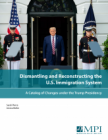Asylum Seekers
Asylum Seekers
Recent Activity
Recent Activity
Policy Briefs
June 2020
El acuerdo de cooperación migratoria firmado por los gobiernos de México y Estados Unidos en junio de 2019 marcó el comienzo de un intenso período de cambio en las políticas mexicanas, con efectos en su frontera compartida. Un año después, el informe examina cambios en los sistemas de control migratorio y protección humanitaria de México. También explora cómo la pandemia del COVID-19 ha afectado la frontera y destaca oportunidades para el desarrollo de políticas en el futuro.














